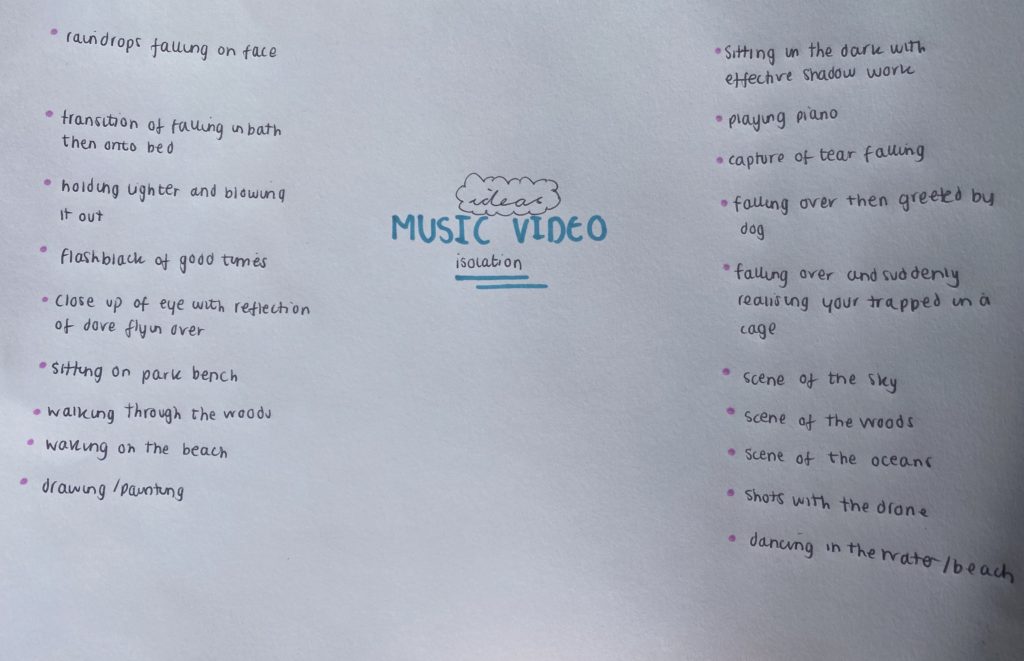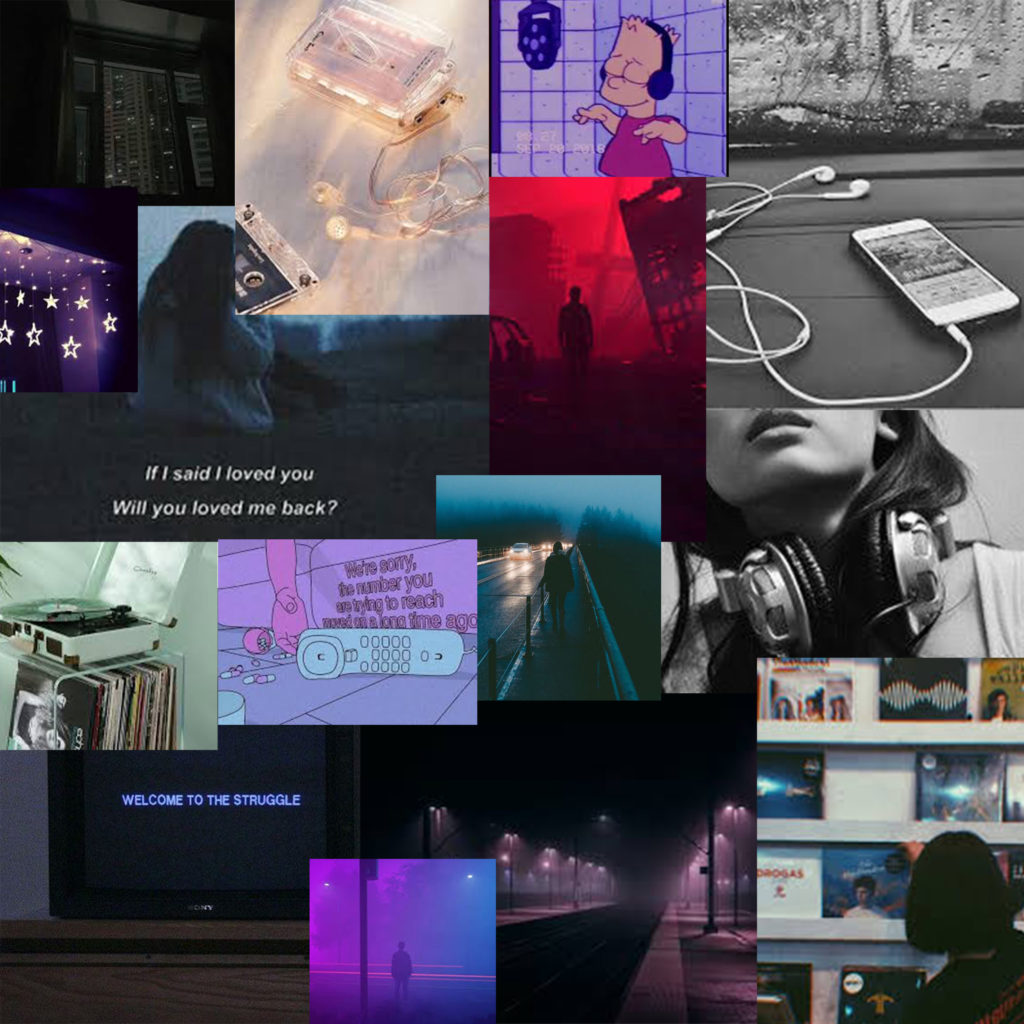- Pastiche
a literary, musical, artistic or architectural work that imitates the style of previous work
- Bricolage
construction (of an idea or sculpture) using whatever comes to hand
- Goodbye, Goodbye uses this method, with the lyrics being written and many different common forms of meidum
- Intertextuality
the complex interrelationship between a text and others taken as basic to the creation or interpretation of a text
- Implosion
the action of bringing to or to a center
- cultural appropriation
the adoption of elements of one culture (usually a minority) by members of another culture (usually a majority)
Handy styles of music videos guide:
addendum: (13/07/2020)
postmodernism – understood as a philosophy that is characterised by concepts such as RE-IMAGINING, PASTICHE, PARODY, COPY, BRICOLAGE. It’s an approach towards understanding, knowledge, life, being, art, technology, culture, sociology, philosophy, politics and history that is REFERENTIAL – in that it often refers to and often copies other things in order to understand itself.
- silly
music videos are often very postmodernism
re-imagining – looking at a source and re creating it from your own perspective
new expressions of identity and meaning are actually new iterations of previous expressions of popular culture
- It is therefore possible to understand postmodernism as a complicated and fragmentary set of inter-relationships, a practice of re-imagining, pastiche, bricolage and self-referentiality, which may be understood alongside another key expression / concept: intersectionality
intersectionality – small divisions in society (e.g. a white feminist’s experience is going to be different from a black feminist’s)
PARODY v PASTICHE
PARODY
a work or performance that imitates another work or performance with ridicule or irony
PASTICHE
is a work of art, drama, literature, music, or architecture that imitates the work of a previous artist (e.g a reference or imitation)
the simpsons very often uses pastiche
parody movies focus on surface signs
A good place to look for illustrations of postmodern culture, in terms of media studies, is the music video. As Shuker notes, two points are frequently made about music videos: ‘their preoccupation with visual style, and associated with this, their status as key exemplars of ‘postmodern’ texts.’ (2001:167). Shuker refers Fredric Jameson’s (1984) notion of the ‘metanarrative’ (discussed in more detail below) that ’embody the postmodern condition’ (168). For example, the fragmentary, decentred nature of music videos that break up traditional understandings of time and space so that audiences are ‘no longer able to distinguish ‘fiction’ from ‘reality’, part of the postmodern condition’ (ibid). Alongside their similarity to adverts (essentially the music video is a commercial tool to sell music products) ‘making them part of a blatantly consumerist culture‘ (ibid). And of course, the ‘considerable evidence of pastiche, intertextuality and eclecticism‘ (ibid) which is the focus of this next section.
Bricolage – a useful term to apply to postmodernist texts as it ‘involves the rearrangment and juxtaposition of previously unconnected signs to produce new codes of meaning’ (Barker & Jane, 2016:237).
intertextuality – another useful term to use, as it suggests signs only have meaning in reference to other signs and that meaning is therefore a complex process of decoding/encoding with individuals both taking and creating meaning in the process of reading texts.
if the priority is play then the emphasis is on the surface:
in other words, if the main focus is the idea of just connecting one product to another, then the focus is superficial, shallow, lacking depth, so ‘in a postmodern world, surfaces and style become the most important defining features of the mass media and popular culture‘ (Strinati: 234). The emphasis of style and surface over substance, means that what something looks like becomes more important than anything else, as opposed to what something might mean, or what it could be used for.
richard hoggart
richard hoggart noticed the shift in modern societies particularly the impact of ‘neighbourhood lives’
- locality, until the shift in globalisation causing the world to be populated by ‘consumers’
- most of society does not make anything and consumes more than creates
- postmodernism is linked to capitalism: with the need to consume put over everything else
- consummation is the desire to continue to desire. For example, coke adverts advertise enjoyment which draws consumers in as they want to enjoy
fragmental consumption = fragmental identities
This process of fragmented consumption separating, splitting up and dividing previously homogeneous groups such as, friends, the family, the neighborhood, the local community, the town, the county, the country and importantly, is often linked to the process of fragmented identity construction.
Again think about mobile telephony which is now able to construct multiple possibilities identities, at multiple moments in time and space. Think about the way we construct, our (multiple) digital identities, visable and varying across different digital platforms – work identity, social identity, family identity etc, which is most often not consistent with our analogue (human?) identity – look for example, at your profile pictures?
As an example, mobile telephony (both hardware and software) now appears to proliferate and connect every aspect of our lives, and generally does so from the perspective of consumption – consuming images, sounds, stories, messages etc – rather than production. We don’t make mobile phones, mobile networks (hardware) or Apps, content and platforms (software).
So in summary, the focus on FRAGMENTATION OF IDENTITY is characterised and linked to an increase of consumption and the proliferation of new forms of digital technologies. In effect, another key characteristic of postmodernism is the development of fragmented, alienated individuals living (precariously) in fragmented societies.
The loss of a metanarrative (overall narrative)
A good starting point would be to return to the concepts of PASTICHE and PARODY, as Fredric Jameson claimed that Postmodernism is characterized by pastiche rather than parody which represents a crisis in historicity.
Jameson argued that parody implies a moral judgment or a comparison with previous societal norms. Whereas pastiche, such as collage and other forms of juxtaposition, occur without a normative grounding and as such, do not make comment on a specific historical moment. As such, Jameson argues that the postmodern era is characterised by pastiche (not parody) and as such, suffers from a crisis in historicity.
This links to Jean-Francois Lyotard’s proposition that postmodernism holds an ‘incredulity towards meta-narratives‘ (1979:7) those overarching ideas, attitudes, values and beliefs that have held us together in a shared belief, For example, the belief in religion, science, capitalism, communism, revolution, war, peace and so on.
Lyotard points out that no one seemed to agree on what, if anything, was real and everyone had their own perspective and story. We have become alert to difference, diversity, the incompatibility of our aspirations, beliefs and desires, and for that reason postmodernity is characterised by an abundance of micronarratives.[28]
It can be also characterised as an existence without meaning, as Žižek suggests it is an existence without ‘The Big Other’ , an existentialistt crisis of existence when we realise we are alone (Lacan).
Strinati points out that ‘the distinction between culture and society is being eroded’ (231) and suggests that our sense of reality (the overarching metanarrative) appears to come from the culture (eg the media), rather than from society which is then reproduced, represented and relayed through media communication. In terms of media studies, this marks a juncture from previous conceptions of mass media communication, for example, as a ‘relay system’ – a process which just relays information and events in real time to a mass society, or the conception of the media as a ‘window on the world’ (Strinati:233).
From a societal perspective the ‘real’ seems to be imploding in on itself, a ‘process leading to the collapse of boundaries between the real and simulations’ (Barker & Emma, 2015:242). A process which the French intellectual Jean Baudrillard would describe as IMPLOSION which gives rise to what he terms SIMULACRA. The idea that although the media has always been seen as a representation of reality – a simulation, from Baudrillard’s perspective of implosion, it is has become more than a representation or simulation and it has become SIMULACRUM not just a representation of the real, but the real itself, a grand narrative that is ‘truth‘ in its own right: an understanding of uncertain/certainty that Baudrillard terms the HYPERREAL.
reflexivity –











